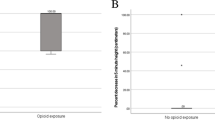Abstract
Adverse effects of opioids on the gastrointestinal tract are well known. However, with the rising epidemic of opioids, its detrimental effects on esophageal physiology are now being increasingly recognized. In this commentary, we briefly review the current evidence behind opioid-induced esophageal dysfunction with potential pathophysiology and treatment options.

Similar content being viewed by others
References and Recommended Reading
Vowles KE, McEntee ML, Julnes PS, et al. Rates of opioid misuse, abuse, and addiction in chronic pain: a systematic review and data synthesis. Pain. 2015;156:569–76.
Choung RS, Locke GR 3rd, Zinsmeister AR, et al. Opioid bowel dysfunction and narcotic bowel syndrome: a population-based study. Am J Gastroenterol. 2009;104:1199–204.
Gomes T, Tadrous M, Mamdani MM, et al. The burden of opioid-related mortality in the United States. JAMA Network Open. 2018;1:e180217.
Camilleri M, Lembo A, Katzka DA. Opioids in gastroenterology: treating adverse effects and creating therapeutic benefits. Clin Gastroenterol Hepatol. 2017;15:1338–49.
Camilleri M. Opioid-induced constipation: challenges and therapeutic opportunities. Am J Gastroenterol. 2011;106:835–42.
Dowlatshahi K, Evander A, Walther B, et al. Influence of morphine on the distal oesophagus and the lower oesophageal sphincter--a manometric study. Gut. 1985;26:802–6.
Penagini R, Bianchi PA. Effect of morphine on gastroesophageal reflux and transient lower esophageal sphincter relaxation. Gastroenterology. 1997;113:409–14.
Kraichely RE, Arora AS, Murray JA. Opiate-induced oesophageal dysmotility. Aliment Pharmacol Ther. 2010;31:601–6.
Penagini R, Picone A, Bianchi PA. Effect of morphine and naloxone on motor response of the human esophagus to swallowing and distension. Am J Physiol. 1996;271:G675–80.
Gonzalez ES, Bellver VO, Jaime FC, et al. Opioid-induced lower esophageal sphincter dysfunction. J Neurogastroenterol Motil. 2015;21:618–20.
Ratuapli SK, Crowell MD, DiBaise JK, et al. Opioid-induced esophageal dysfunction (OIED) in patients on chronic opioids. Am J Gastroenterol. 2015;110:979–84.
Savilampi J, Magnuson A, Ahlstrand R. Effects of remifentanil on esophageal motility: a double-blind, randomized, cross-over study in healthy volunteers. Acta Anaesthesiol Scand. 2015;59:1126–36.
Ravi K, Murray JA, Geno DM, et al. Achalasia and chronic opiate use: innocent bystanders or associated conditions? Dis Esophagus. 2016;29:15–21.
Wood JD, Galligan JJ. Function of opioids in the enteric nervous system. Neurogastroenterol Motil. 2004;16(Suppl 2):17–28.
Sternini C, Patierno S, Selmer IS, et al. The opioid system in the gastrointestinal tract. Neurogastroenterol Motil. 2004;16(Suppl 2):3–16.
Pasternak GW. Pharmacological mechanisms of opioid analgesics. Clin Neuropharmacol. 1993;16:1–18.
Greenwald MK, Stitzer ML, Haberny KA. Human pharmacology of the opioid neuropeptide dynorphin A(1–13). J Pharmacol Exp Ther. 1997;281:1154–63.
Bagnol D, Mansour A, Akil H, et al. Cellular localization and distribution of the cloned mu and kappa opioid receptors in rat gastrointestinal tract. Neuroscience. 1997;81:579–91.
Rattan S, Goyal RK. Identification and localization of opioid receptors in the opossum lower esophageal sphincter. J Pharmacol Exp Ther. 1983;224:391–7.
Scarpellini E, Pauwels A, Vos R, et al. Effect of methylnaltrexone and naloxone on esophageal motor function in man. Neurogastroenterol Motil. 2017;29.
Kahrilas PJ, Bredenoord AJ, Carlson DA, et al. Advances in management of esophageal motility disorders. Clin Gastroenterol Hepatol 2018.
Ortiz V, Garcia-Campos M, Saez-Gonzalez E, et al. A concise review of opioid-induced esophageal dysfunction: is this a new clinical entity?. Dis Esophagus 2018;31.
Author information
Authors and Affiliations
Contributions
DP, drafting of manuscript and acquisition of data and MV, acquisition of data and critical revision of the manuscript.
Corresponding author
Ethics declarations
Conflict of interest
Dhyanesh Patel declares that he has no conflict of interest. Michael Vaezi declares that he has no conflict of interest.
Rights and permissions
About this article
Cite this article
Patel, D., Vaezi, M. Opioid-Induced Esophageal Dysfunction: An Emerging Entity with Sweeping Consequences. Curr Treat Options Gastro 16, 616–621 (2018). https://doi.org/10.1007/s11938-018-0210-2
Published:
Issue Date:
DOI: https://doi.org/10.1007/s11938-018-0210-2




